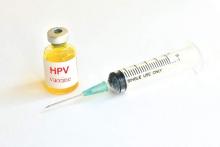As human papillomavirus vaccination rates climbed in New Mexico, all grades of cervical intraepithelial neoplasia declined in females aged 15-19 years, and grade 2 neoplasia fell among those who were aged 20-24 years, according to an analysis published online Sept. 29 in JAMA Oncology.
In the 15- to 19-year-old group, the annual incidence of cervical intraepithelial neoplasia (CIN) 1 dropped from 3,468 cases per 100,000 individuals screened in 2007 to 1,591 in 2014, an annual percentage change (APC) of –9.0.
CIN2 cases fell from 896 to 415 (APC, –10.5), and CIN3 from 240 to 0 (APC, –41.3). Among women aged 20-24 years, CIN2 annual incidence fell from 1,028 to 627 cases per 100,000 women screened (APC, –6.3).
The reductions were greater than expected, given that only 40% of females aged 13-17 years had received all three doses in 2014, up from 17% in 2008. It’s likely that herd immunity, benefit from even partial vaccination, and cross-protection against HPV strains not in vaccines contributed to the success, reported Vicki B. Benard, PhD, of the Centers for Disease Control and Prevention, and her colleagues (JAMA Oncol. 2016 Sept. 29. doi: 10.1001/jamaoncol.2016.3609).
The investigators adjusted their findings to account for trends towards longer intervals between cervical screenings and later initiation of screening. Otherwise, the effect of the vaccine would have been overestimated.
The ultimate goal “is a rational integration of HPV vaccination and cervical screening,” they wrote. Current cervical cancer screening guidelines do not differentiate between women who have been vaccinated and those who have not, but this should be reevaluated in light of the study findings, the researchers noted.
“Our data demonstrate that clinical outcomes of CIN will be reduced among cohorts [even] partially vaccinated for HPV,” which will reduce the cost-effectiveness of screening. “A later starting age for cervical screening among partially vaccinated populations of young women ... may be prudent given the already infrequent incidence of invasive cervical cancer for women younger than 25 years” even before the HPV vaccine was introduced in 2007, the investigators wrote.
The study focuses on data from New Mexico because it is the only state that has captured population-based estimates of both screening prevalence and CIN since the introduction of the vaccine.
The National Institute of Allergy and Infectious Diseases funded the work. Dr. Benard reported having no financial disclosures, but other investigators reported ties with HPV vaccine makers Merck and GSK, among other companies.


